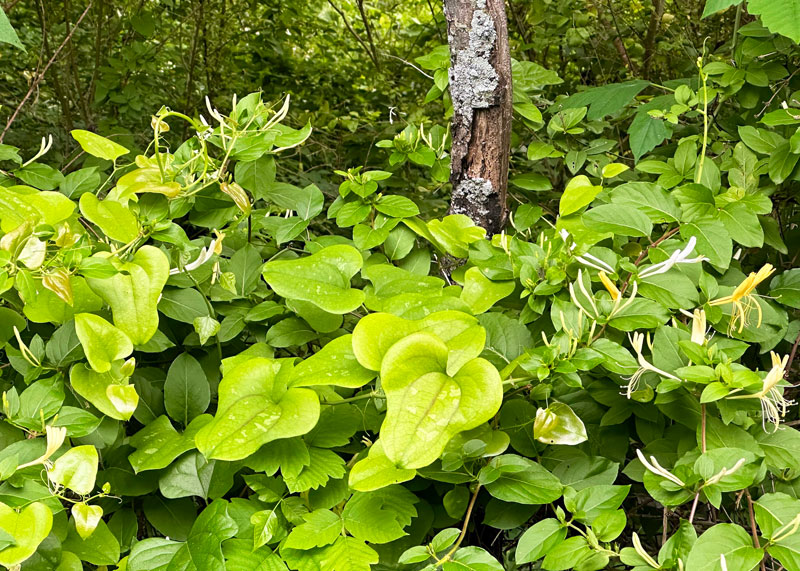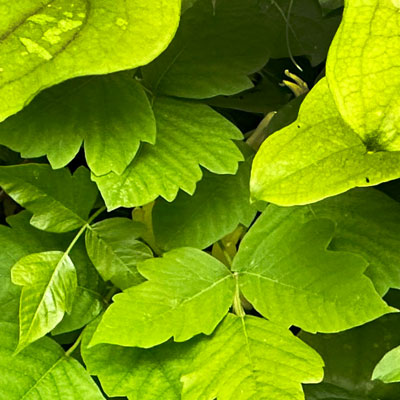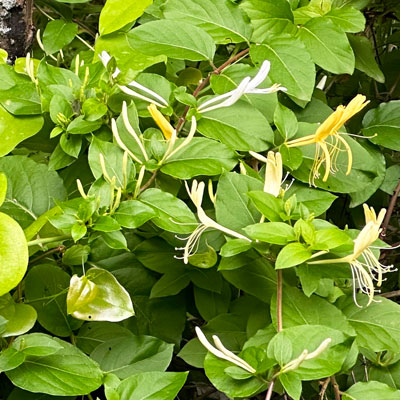Horror Show of the High Wire
We live out in the country. Way out. No one has lived across the road for probably 10 years and weeds and vines have pretty much taken over.

I wouldn’t mind so much if the vines would stay over there, but they seed themselves freely and a disproportionate share end up in our yard. Each of these three requires specialized care in successful removal. I’ll explain how I do it.
What is a “broadleafed” weedkiller?
Horticulturists (as opposed to pure botanists) categorize weeds into two groups. Either a weed is a grass (Johnsongrass, crabgrass, grassburs, etc.) or it isn’t a grass. That second group gets called “broadleafed” weeds. That’s not necessarily because they have wide leaves. It’s just a term that’s used to describe plants that aren’t grasses.
Grasses have parallel veins in their leaves. Broadleafed weeds, by comparison, almost always have blades that are pinnately or palmately veined – generally not parallel. Most grasses have dry, chaffy seeds. Many broadleafed plants have fleshy seeds or fruit. Grass flowers are seldom coloful or showy. Broadleafed flowers often are.
Broadleafed weedkillers contain a growth hormone type chemical called 2,4-D. Many also contain two other herbicides in a blend that is called “Trimec.” 2,4-D must enter the weeds through their leaves. The components of Trimec enter through the roots. That’s what makes them more of a risk when applying them within the drip line of desirable trees and large shrubs.

Control of Poison ivy…
You certainly do not want to touch any part of the plant ever, even dried tissues. Wear long sleeves and pants and washable or disposable gloves.
Cut poison ivy stems off where they come out of the ground. Use either lopping shears or a sharpened hoe to make the cut. Do not touch the cutting surface. If possible, use the lopping shears to cut the stems of the ivy into smaller lengths, then lift then out of the support with the head of the loppers. Rake and remove the stubble without touching it.
Apply broadleafed weedkiller with a tank sprayer to any new sprouts as they emerge from the ground.

Control of Smilax briar…
Sprays are almost useless with this aggressive vine. It is strong growing, but it has too few leaves to absorb much of the herbicide. And its roots are large and fleshy.
I have found that simply cutting the plants completely to the ground eliminates probably 95 percent of the smilax outbreak on our property. What few plants remain I can easily dig out with my sharpshooter spade. Generally, there is either a large tuber or a cluster of pencil-sized roots, and if I can remove either of those, I can get rid of the colony.

Control of Honeysuckle…
This vine climbs by twining around its support. Since that is often shrubs, spraying is out of the question. Removing it by trimming and pulling it loose is especially unfulfilling because its stems are so slimy.
I have found that I can usually track a large plant back to one root system. If I can find where it comes up out of the ground, I can clip the stem at that point and kill all the growth with the one cut. I let it dry for a few days and it’s much easier to remove. If I need it out sooner, I clip the wilted stems and “unscrew” them from the supporting plant. It sounds silly, but it will make a lot of sense when you try it.
So, there you have three obnoxious invaders and how each of them should be controlled. Better yet: keep them off your fence and you and your neighbors won’t have to worry with them at all.
